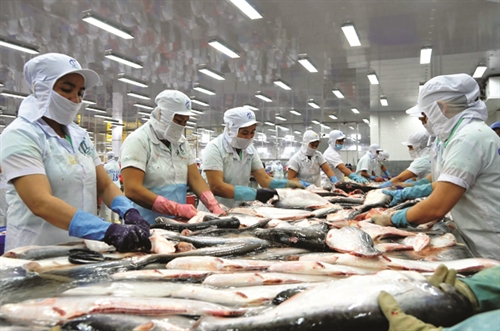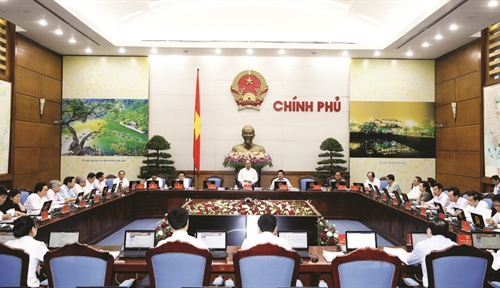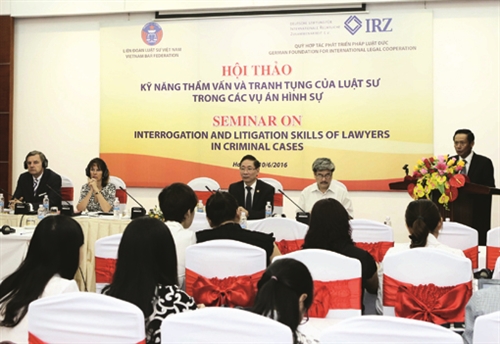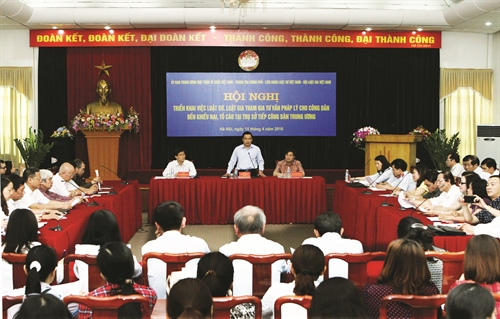Nguyen Hong Thao
The Award of the Arbitral Tribunal constituted under Annex VII to the 1982 United Nations Convention on the Law of the Sea (UNCLOS) in the arbitration instituted by the Philippines against China has marked a turning point in the settlement of the East Sea (South China Sea) dispute.[1] However, the reactions of countries and complicated political situation have led to undesirable results. China remains loyal to its four “no” policy (non-participation, non-recognition of the Tribunal’s jurisdiction, non-acceptance and non-enforcement of the Award)[2], and continues to oppose the Award. Philippine President Rodrigo Duterte’s policy to pivot from the United States under leadership of President Barack Obama to China has shadowed the ruling as a victory of the Philippines. The change of the US president has brought about unforeseeable developments in the policies of the US and regional countries.[3] ASEAN could not reach agreement on a joint statement on the ruling. The effect of the ruling and its future application remain unanswered questions.
Effect of the Award
Article 11 of Annex VII states: “The award shall be final and without appeal.” Article 12 adds: “Any controversy which may arise between the parties to the dispute as regards the interpretation or manner of implementation of the award may be submitted by either party for decision to the arbitral tribunal which made the award.” Being state parties to the UNCLOS, both the Philippines and China are bound to obey Annex VII, which contains the provisions with which the ruling has complied. In case either party refuses to accept the award or there remains any controversy between the parties, either of them is entitled to request the Tribunal to further interpret its ruling.[4]
Immediately after the ruling was issued, China made a statement to reject it and call for the settlement of the dispute through bilateral negotiation[5]. The reasons cited by China include: The Tribunal has no jurisdiction and violates China’s reservation under Article 298 of the UNCLOS, the creation of the Tribunal according to the appointment of a Japanese judge is biased, and the Tribunal’s ruling is not a source of international law, so China commits no breach.
As regards the Philippines, this legal victory has posed new issues to its new President Rodrigo Duterte. He must ensure gaining of fishing rights for his people in Scarborough Shoal (the main goal of the arbitration) and modernization of the naval and coast guard forces in order to enforce the ruling. These are hard nuts to crack as the new Philippines administration lacks potential and pursues the policy of seeking foreign investment while the US does not eagerly respond to it. Before his official visit to Beijing in September 2016, President Duterte said the Tribunal’s ruling was “a piece of paper with four corners” and decided to put the enforcement of the ruling behind other pressing issues between the two countries.[6]
The subsequent developments show that the two countries seem to have reached a tacit agreement on marine cooperation. China has reduced its marine surveillance force and Philippine fishermen are allowed to access fish sources at Scarborough Shoal (Hoang Nham bank). On November 21, 2016, President Duderte unilaterally declared to establish Panatag lagoon as a marine sanctuary. He also said that Chinese and Philippine leaders had discussed on marine cooperation on the sidelines of the Asia Pacific Economic Cooperation (APEC) Summit[7] held in Peru. This move aims to restrict Philippine and Chinese fishermen in the area and to prevent Beijing from further building works on the seven low-tide elevations in the Spratly archipelago. However, it can be considered as a step down from Manila when Filippino fishermen are unilaterally being banned to access to the Protected Marine Area. This policy will unconsciously strength the annual fishing ban (from 1 June to 31 August) imposed by China under the same umbrella of protection of marine living resources. since 1998. China has made “separate arrangements” for fishing activities by Philippine fishermen in adjacent waters but still asserted that its sovereignty and jurisdiction over Hoang Nham bank has not changed and will not change.”[8] A non-disputed has gradually being transformed to disputed and joint exploitation area in setting aside the dispute.
The Philippines v. China arbitration is a special case in the application and interpretation of the UNCLOS in the absence of one party. Article 9 of Annex VII to the UNCLOS provides: “If one of the parties to the dispute does not appear before the arbitral tribunal or fails to defend its case, the other party may request the tribunal to continue the proceedings and to make its award. Absence of a party or failure of a party to defend its case shall not constitute a bar to the proceedings. Before making its award, the arbitral tribunal must satisfy itself not only that it has jurisdiction over the dispute but also that the claim is well founded in fact and law.” In the course of consideration, the Tribunal made cautious assessments through issuing two rulings on jurisdiction and admissibility before coming to a conclusion that it had jurisdiction over the arbitration and the Philippine petition (consisting of 15 points) is well founded in fact and law. The exceptions presented in China’s position documents were analyzed and rejected one by one in a persuasive manner by the Tribunal in these two rulings.[9] The reason that the five-member tribunal is biased because it was established through the appointment by judge Shunji Yanai, a Japanese citizen, who serves as President of the International Tribunal for the Law of the Sea (ITLOS), is unpersuasive because China was totally able to participate in the process of selecting arbiters but it opted to be absent. The ITLOS judges are those who have been assessed and selected in a strict manner, ensuring that they are legally competent and impartial in their work. Being parties to the ITLOS, both China and the Philippines had participated in this selection process. Rulings of judicial courts do not constitute a primary source of international law but they are “subsidiary means” as prescribed in Article 38 of the Statute of the International Court of Justice (ICJ). Article 287 of the UNCLOS prescribes the right to freely choose various means for the settlement of disputes, including an arbitral tribunal constituted under Annex VII. Article 296 of the UNCLOS provides: “Any decision rendered by a court or tribunal having jurisdiction under this section shall be final and shall be complied with by all the parties to the dispute.” Since the UNCLOS and arbitral tribunals have no enforcement mechanism, so the compliance with the obligations arising from such treaties as UNCLOS must be in the spirit of pacta sunt servanda and bone foi, relying on the good faith of the involved parties. This obligation is affirmed in Article 26 of the 1969 Vienna Convention on the Law of Treaties.[10]
There are precedents in history on the non-enforcement of arbitral awards. In 1986, in the case of military and paramilitary activities in and against Nicaragua, the ICJ concluded that the US breached its obligations not to use force and threaten to use force against another state and not to intervene in the affairs of another state and demanded the US to terminate its support for contra forces against the Government of Nicaragua and to make reparation to Nicaragua. The US opposed and refused to obey the ICJ’s ruling. In 1990, when the new administration in Nicaragua did not claim compensation, the two countries normalized their relations. The US stopped providing aid for contra forces and lifted its trade embargo on Nicaragua. In the Arctic Sunrise case in 1990, the ship and its crew were released although Russia previously declared to not accept the ruling of the International Tribune for the Law of the Sea (ITLOS). The rulings were ultimately enforced on the basis of good faith, flexible diplomacy, saving face for major powers and observance of international law.
 |
| An international conference on legal issues relating to awards of the Arbitral Tribunal established under Annex VII to the 1982 UNCLOS __Photo: Hoang Hoa/VNA |
Effect of the Award for other countries
The Award is not binding on other parties. However, the legal reasoning of the award can be accepted and applied by other for similar disputes. Through interpretation of the UNCLOS, the ruling clearly points out legitimate interests which third-party states are entitled to. These states may apply this ruling to protecting these interests. These interests do exist but are hidden by disputes and different ways of interpretation. In other words, the ruling, through interpretation of the UNCLOS, helps bring out the erga omnes obligations: All states are bound to respect common interests of the international community and to protect common legal interests. These obligations were affirmed by the ICJ in the Barcelona Traction case in 1970[11] and have been strengthened by its subsequent awards.
The questions here are: What are erga omnes interests of other states in the East Sea and how will they be affected if the involved parties to the arbitration case disregard the ruling?
The biggest contribution of the Award is that it narrows the disputed maritime area, creating conditions for the parties to negotiate and settle their maritime disputes independently or in connection with sovereignty disputes. It has clarified some basic concepts for which the UNCLOS fails to provide specific definitions or assessment criteria.
First of all, the ruling clarifies the legal content of historic rights and entitlements, thus rejecting China’s nine-dash line maritime claim. Based on China’s acts and declarations, the Tribunal concluded that China claims rights to petroleum resources and fisheries within the nine-dash line on the basis of historic rights existing independently of the Convention.[12] These rights are entirely contrary to the Convention and legally null and void because they fall beyond the geographical boundaries and the nature of China’s maritime entitlements under the Convention.[13] With this conclusion, there will be no overlap between the exclusive economic zones and continental shelves from the mainland territories of the states and the scope of the nine-dash line and, therefore, there is no dispute. This conclusion will also create a precedent that can be applied to all claims to historic rights of other states in the East Sea region and beyond, existing independently of the Convention. There is no discrimination against only the nine-dash line.
Second, the Tribunal put forward criteria for assessment of the term rock and its legal status in Article 121.3. This is the most controversial article in the UNCLOS. The Tribunal held that the conditions for a rock appropriate for human inhabitation or a separate economic life depends on the objective possibility of the feature, on natural conditions, the ability to maintain a stable human community or economic activity without relying on external resources or is exploited in an absolutely natural manner. The Tribunal introduced 10 criteria for assessment:
1) The use of the word “rock” in Article 121.3 does not limit the provision to features composed of solid rock. The geological and geomorphological characteristics of a rock are diverse, being coral, sand or mud, provided that it is a high-tide feature.
2) The status of a feature is to be determined on the basis of its natural capacity, without external additions or modifications intended to increase its capacity to sustain human habitation or an economic life of its own.
3) The term “human habitation” should be understood to involve the inhabitation of the feature by a stable community of people for whom the feature constitutes a home and on which they can remain. Such a community need not necessarily be large, and in remote atolls a few individuals or family groups could well suffice. Periodic or habitual residence on a feature by a nomadic people could also constitute habitation.
4) The term “economic life of their own” is linked to the requirement of human habitation. Article 121.3 does not refer to a feature having economic value, but to sustaining “economic life”. The “economic life” in question will ordinarily be the life and livelihoods of the human population inhabiting and making its home on a maritime feature or group of features. The economic life in question must pertain to the feature as “of its own”. Economic life, therefore, must be oriented around the feature itself and not focused solely on the waters or seabed of the surrounding territorial sea. Economic activity that is entirely dependent on external resources or devoted to using a feature as an object for extractive activities without the involvement of a local population would also fall inherently short with respect to this necessary link to the feature itself. Extractive economic activity to harvest the natural resources of a feature for the benefit of a population elsewhere certainly constitutes the exploitation of resources for economic gain, but it cannot reasonably be considered to constitute the economic life of an island as its own.
5) The text of Article 121.3 is disjunctive, such that the ability to sustain either human habitation or an economic life of its own would suffice to entitle a high-tide feature to an exclusive economic zone and continental shelf. However, as a practical matter, the Tribunal considers that a maritime feature will ordinarily only possess an economic life of its own if it is also inhabited by a stable human community. One exception to that view should be noted for the case of populations sustaining themselves through a network of related maritime features. A population whose livelihood and economic life extends across a constellation of maritime features is not disabled from recognizing that such features possess an economic life of their own merely because not all of the features are directly inhabited.
6) The capacity of a maritime feature to sustain human habitation or an economic life of its own is necessarily an objective. It has no relation to the question of sovereignty over the feature.
7) The capacity of a feature to sustain human habitation or an economic life of its own must be assessed on a case-by-case basis. The principal factors that contribute to the natural capacity of a feature can be identified. These would include the presence of water, food, and shelter in sufficient quantities to enable a group of persons to live on the feature for an indeterminate period of time. Such factors would also include considerations that would bear on the conditions for inhabiting and developing an economic life on a feature, including the prevailing climate, the proximity of the feature to other inhabited areas and populations, and the potential for livelihoods on and around the feature. The relative contribution and importance of these factors to the capacity to sustain human habitation and economic life, however, will vary from one feature to another.
8) With regard to a group of features that collectively form part of a network that sustains human habitation or an economic life of its own, the Tribunal would not equate the role of multiple islands in this manner with external supply. Nor would the local use of nearby resources as part of the livelihood of the community equate to the arrival of distant economic interests aimed at extracting natural resources.
9) Evidence of physical conditions will ordinarily suffice only to classify features that clearly fall within one category or the other. If a feature is entirely barren of vegetation and lacks drinkable water and the foodstuffs necessary even for basic survival, it will be apparent that it also lacks the capacity to sustain human habitation. The opposite conclusion could likewise be reached where the physical characteristics of a large feature make it definitively habitable. The Tribunal considers, however, that evidence of physical conditions is insufficient for features that fall close to the line. It will be difficult, if not impossible, to determine from the physical characteristics of a feature alone where the capacity merely to keep people alive ends and the capacity to sustain settled habitation by a human community begins. This will particularly be the case as the relevant threshold may differ from one feature to another.
10) The most reliable evidence of the capacity of a feature will usually be the historical use to which it has been put. If the historical record of a feature indicates that nothing resembling a stable community has ever developed there, the most reasonable conclusion would be that the natural conditions are simply too difficult for such a community to form and that the feature is not capable of sustaining such habitation. In the absence of such intervening forces, like war, pollution, and environmental harm, the Tribunal can reasonably conclude that a feature that has never historically sustained a human community lacks the capacity to sustain human habitation. Evidence of human habitation that predates the creation of exclusive economic zones may be more significant than contemporary evidence, if the latter is clouded by an apparent attempt to assert a maritime claim.[14]
Applying the above-said criteria, the Tribunal reached a conclusion that none of the high-tide features in the Spratly archipelago is inappropriate for human habitation or an economic life on its own, and therefore, it can create only a 12-nautical-mile territorial sea.
These criteria may also constitute a legal reasoning and departing point for the consideration and settlement of disputes over rocks of similar sizes and with historical circumstances like Rockall and Shag Rocks claimed by the United Kingdom, Okinotorishima by Japan, Clipperton in the Pacific Ocean, Tromelin in the Indian Ocean or Jabal al-Tair between Etriea and Yemen or the Paracels in the East Sea. They should be considered on a case-by-case basis as recommended by the Tribunal as regards uninhabited big islands such as Jan Mayen Island, Abel Island and Heard Island.
The Tribunal also considered the status of low-tide elevations. All states have the right to build artificial islands on the condition of respect for the jurisdiction of coastal states over their exclusive economic zones and continental shelves. Since these elevations have no status of a rock, they create no territorial sea except a safety zone of up to 500 m around them. The low-tide elevations located within 12 nautical miles of the surrounding rocks may be used as baseline points for measuring the territorial seas of these rocks. Their status may be determined on a case-by-case basis only.
With these conclusions, the Tribunal “liberated” a vast maritime zone from the dispute due to claims over overlapping maritime zones measured from the 33 rocks and some 700 low-tide elevations belonging to the Spratly archipelago. On the basis of the diagrams, the overlapping 12-nautical-mile territorial seas between the rocks are very few. This means that the number of maritime delimitation cases in the future will reduce considerably. The Tribunal also asserted that the Spratly archipelago should not be regarded as an organically linked entity but scattered rocks and low-tide elevations. Then, any calculations to claim the Spratly as an archipelago like the Kalaayan of the Philippines is unconformable with the UNCLOS. The consequence is that there will be no maritime zone that can be claimed from the baseline around the Kalaayan.
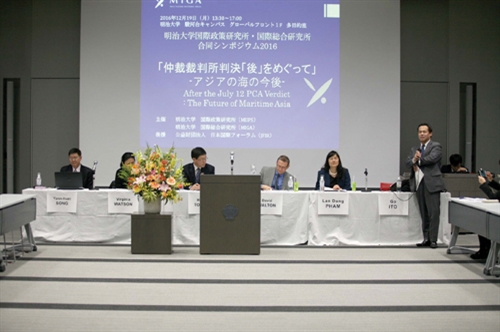 |
| Speakers at the international conference entitled “After the July 12 PCA Verdict: The Future of Maritime Asia” (in Tokyo, Japan) __Photo: Thanh Huu/VNA |
From the above conclusions, in the East Sea:
- There appear the high seas outside the claimed lines of 200-nautical- mile exclusive economic zones from the mainland and large islands of surrounding states: the Philippines, China, Vietnam, Malaysia and Brunei.
- There appears a seabed area of the Common Heritage of Mankind outside the outerlimits of the continental shelves of the surrounding states.
- In these sea areas, all states, whether coastal or landlocked, can exercise the freedom of the high seas (freedom of overflight, freedom of navigation, freedom to lay submarine cables and pipelines, freedom of fishing, freedom of marine scientific research, and freedom to construct artificial islands and other installations permitted under international law) and the right to share natural resources of the seabed under the administration of the International Seabed Authority
- The freedom of overflight, freedom of navigation, freedom to lay submarine cables and pipelines in the exclusive economic zones are respected. Ships and vessels may freely travel in the waters beyond the 12-nautical-mile territorial seas of the disputed rocks and outside the 500-meter safety zones of the low-tide elevations on which troops are stationed.
These freedoms are universally recognized, enshrined in the UNCLOS and regarded as erga omnes rights. Countries with interests may refer to the Award of the Tribunal when they engage in a dispute with either party to the arbitration. If these interests are breached, an arbitration case applying the compulsory dispute settlement mechanism and Annex VII to the UNCLOS similar to the Philippines vs. China case would be activated. The ASEAN members, which are divided into two groups of disputing states and non-disputing states without direct interest in the East Sea, can now realize at least a common interest in the high seas and Area - common heritage of mankind. Laos, a landlocked state or Cambodia, a geographically disadvantaged one, is now entitled to claim its share in the East Sea. The states that have great merchandise volumes passing through the East Sea like the US, Australia, Japan and South Korea would surely not overlook this enormous benefit. The non-acceptance and non-enforcement of the Tribunal’s Award will negatively affect the rights of the countries inside and outside the region. The recent incident around the US underwater drone seized by the Chinese Navy in the waters about 100 miles off from the Philippines Port at Subic Bay showed again the risk.[15]
Future of the ruling
Personal assessments of such a big and complicated issue as the East Sea dispute can never be comprehensive and accurate. However, from the legal arguments on the arbitration case and follow-up realities, there emerge some ideas that may be useful to share.
China’s statement neither to accept nor to obey the Award does not mean that this state will never accept and obey it in the future. After the issuance of the ruling, China has refrained from causing tension at sea, except continuing to sustain the man-made islands. It has even allowed Philippine fishermen to return to fish at Scarborough Shoal and agreed to settle disputes on the basis of international law. It has not withdrawn from the UNCLOS after considering all the pros and cons of the withdrawal. As the East Sea is of geostrategic importance to China, it will never abandon its intention to control the whole sea. Therefore, China will have to find ways to conciliate its rising position and the old world order and its intention to establish a safe strategic backyard and the respect for the marine interests of other states. The new policies of the US President-elect Donald Trump toward the TPP and Asia would create new advantages for China in the East Sea, but China could not alone challenge the international legal order. This, if happens, would undermine the image of a peacefully rising China and worry its neighbors. China proves cautious not to do anything against the Tribunal’s conclusions, except completing the construction of the seven artificial islands before issuance of the ruling. In the long run, non-compliance with the ruling could trigger new disputes with other states when they exercise the freedom of the high seas and common heritage of mankind, which could be unbeneficial to China. While still sticking to its sovereignty claims over the features located within the nine-dash line and continuing to build the low-tide elevations, China would put pressure on the other states to accept the model of “shelving disputes and developing joint exploitation” as it is doing with the Philippines at Scarborough Shoal. Bilateral negotiation would be promoted as it brings about sectional interests (like the Philippines-China negotiations in the wake of the ruling) and sets an example for China to advertise its position on the settlement of the dispute through bilateral negotiation. China has also committed with the ASEAN to early adopt a Code of Conduct in the East Sea. It should not be excluded the possibility that China will continue to build military bases on the new coral banks or establish an Air Defense Identification Zone (ADIZ) in the East Sea. This move is not free but it needs reasons to persuade the international community to accept such zone. Further, China could advocate other states to adopt a separate agreement to interpret Article 121.3 in order to reject the effect of the Award. After the ruling was issued, only seven states have explicitly supported it. A majority of other countries have used diplomatic language such as “recognize”, “note” or “study”, demanding the involved parties to obey the ruling. These are politically calculated moves rather than provide a way of understanding that the international community does not back the ruling.
While the Philippines benefits from the ruling, it is bound to reconsider its protest against the joint commission to the Commission on the Limits of the Continental Shelf prepared by Vietnam and Malaysia, and may join them. This state could promote marine cooperation initiatives (marine scientific research and marine environment protection…) while calling investment from China. As a host country of ASEAN Summit in 2017, the Philippines could cool its relation with China. It’s not mean that Manila would deviate from or avoid the Tribunal’s ruling.[16] Countries would place importance on initiatives in the cooperative management of marine activities (conservation of marine resources, preservation of marine environment and marine scientific research) for common purposes. The negotiations on the sovereignty dispute would remain at an impasse between the two approaches: 1) on a bilateral basis and 2) what is bilateral will be bilaterally negotiated and what is multilateral will be settled multilaterally. Vietnam and China would continue their exchanges on cooperation in the waters outside the mouth of the Gulf of Tonkin pending a final solution to the Paracel issue. The ASEAN’s connecting role could be heightened in case it can act as a representative for the bloc’s interests in the high seas and heritage seabed as well as freedoms on the basis of respect for the jurisdiction of the coastal states in their exclusive economic zones and continental shelves. The ASEAN and China would further promote the COC initiative inclined to conflict management, marine security and marine activities rather than settlement of sovereignty disputes.
The sovereignty dispute remains unsettled. The ruling contributes to reducing marine disputes but this would make sense only when the parties to the arbitration case have a willingness to comply with the ruling and the countries in and outside the region exert pressure on them. The developments following the Nicaragua’s case against the US or Arctic Sunrise case show that major powers pay relative attention to the issue of saving face and a flexible diplomatic policy that helps them overcome this complex would not be a bad approach. Justice needs a long time to change awareness within the states involved in the arbitration case and for other countries to be fully aware of their rightful and valuable interests once advanced technologies permit the maximum exploitation and use of the high seas and heritage seabed. The Award would be fully enforced when the balance of forces and political circumstances change. The East Sea needs a comprehensive solution, political, economic, diplomatic, legal and military, for peace, stability and prosperity.-
https://www.asil.org/blogs/symposium-south-china-sea-arbitration-military-activities-unclos-compulsory-dispute-settlement
https://www.asil.org/blogs/symposium-south-china-sea-arbitration-jurisdiction-arbitral-tribunal-philippines-v-china
Chinese Journal of International Law (2016), Special Issue on Jurisdiction and Admissibility in the South China Sea Arbitration, Downloaded from https://chinesejil.oxfordjournals.org/ at University of Melbourne on November 28, 2016
Li Mingjiang, The South China Sea Arbitration: Turning point in Chinese foreign policy, RSIS N0 205, 12 August 2016, www.rsis.edu.sg
Trump says U.S. not necessarily bound by ‘one China’ policy https://www.reuters.com/article/us-usa-trump-china-idUSKBN1400TY
Duterte is looking to engage with China, but says he wants to put the South China Sea dispute in ‘the back seat’, Oct. 19, 2016
https://www.businessinsider.com/rodrigo-duterte-philippines-south-china-sea-dispute-piece-of-paper-2016-10, He said the tribunal’s ruling was “a piece of paper with four corners”. “The arbitral award gives us the right. China has the historical right. And they’re insisting. In this situation, do we argue, or do we just talk? I would say, let us put it [off] to some other day.”
Nguyen Hong Thao, Legal aspects of the Award of the Arbitral Tribunal regarding the South China Sea case initiated by the Philippines against China, State and Law Journal, August 2016.
www.defense.gov/News/News-Releases/News-Release-View/Article/1032611/statement-by-pentagon-press-secretary-peter-cook-on-incident-in-south-china-sea
James Kraska, Raul “Pete” Pedrozo, China capture US underwater drone violates the law of the sea,
https://www.lawfareblog.com/chinas-capture-us-underwater-drone-violates-law-sea
https://www.washingtonpost.com/world/asia_pacific/recent-developments-surrounding-the-south-china-sea/2016/12/18/8b9476b0-c597-11e6-acda-59924caa2450_story.html?utm_term=.d67e14e1622d


